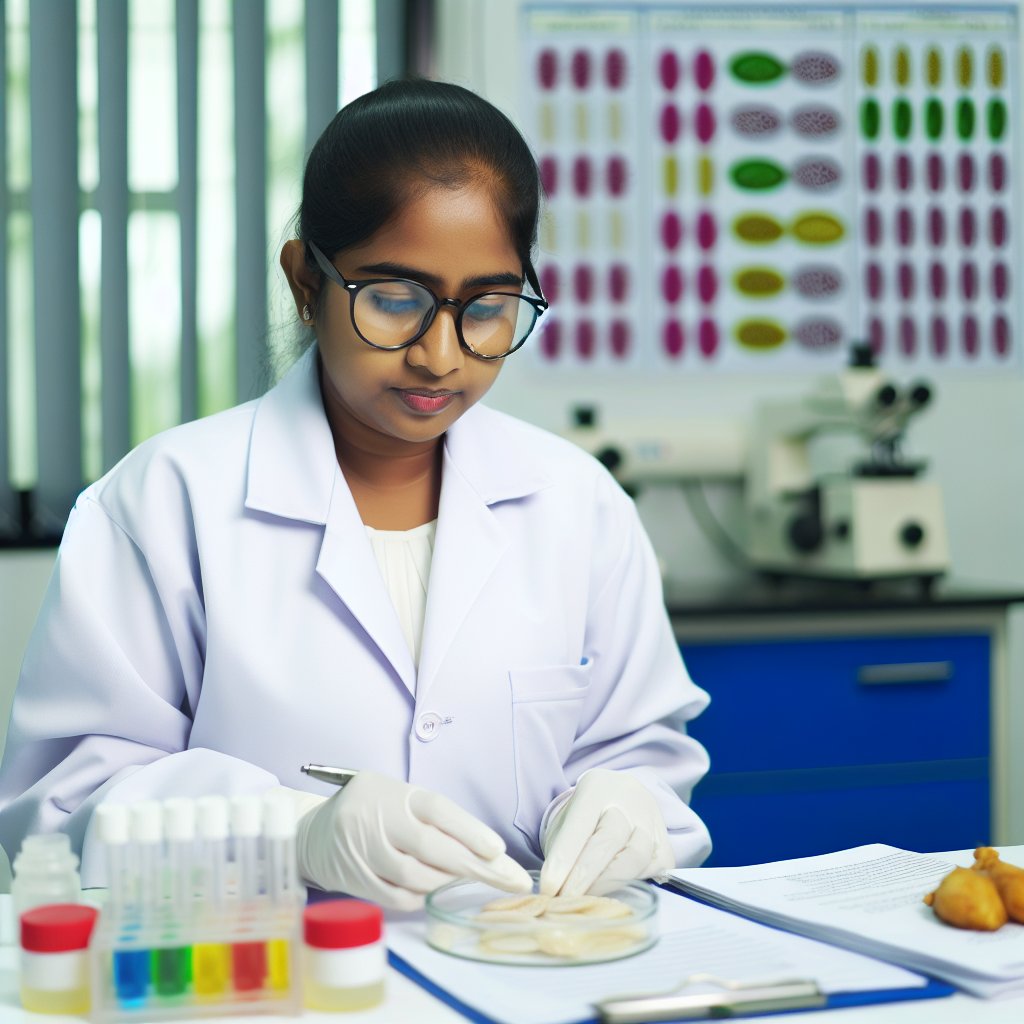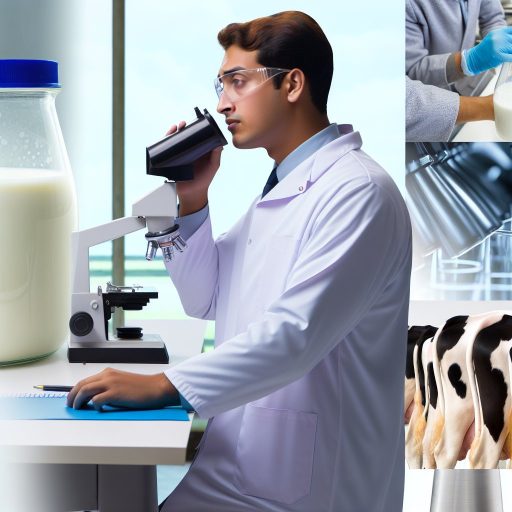Poultry science is the study of poultry production, health, and management.
It focuses on improving productivity.
Food safety is crucial when it comes to poultry products.
Poultry products can harbor harmful bacteria if not handled properly.
Thesis Statement: Poultry science plays a crucial role in ensuring food safety.
This is accomplished by implementing best practices in poultry production.
The Role of Poultry Science in Food Safety:
Poultry science involves the study of poultry production, processing, and distribution.
This scientific field aims to improve the safety and quality of poultry products.
Importance of Poultry Science in Food Safety:
- It plays a vital role in ensuring that poultry products are safe for consumption.
- By understanding poultry production processes, scientists can identify potential risks.
- Research in poultry science helps in developing strategies to mitigate foodborne illnesses.
- It enables the implementation of best practices for handling and processing poultry products.
Technologies Used in Poultry Science:
- Genomic sequencing to identify pathogens in poultry production.
- Advanced processing techniques to minimize contamination during production.
- Quality control measures to ensure poultry products meet safety standards.
- Traceability systems to track poultry products from farm to table.
Practices in Poultry Science for Food Safety:
- Regular monitoring of poultry farms for hygiene and sanitation practices.
- Training programs for poultry farmers and workers on food safety protocols.
- Implementation of Hazard Analysis and Critical Control Points (HACCP) programs.
- Collaboration with regulatory agencies to enforce food safety regulations.
Poultry science plays a crucial role in ensuring the safety and quality of poultry products.
Through research, technology, and best practices, this scientific field continues to advance food safety standards in the poultry industry.
Common Food Safety Concerns in Poultry Products:
Overview of common pathogens found in poultry, such as Salmonella and Campylobacter.
Explanation of how these pathogens can cause foodborne illnesses if poultry products are not handled and cooked properly.
Statistics on foodborne illnesses related to poultry products.
Overview of common pathogens found in poultry:
Salmonella and Campylobacter are two of the most common pathogens found in poultry products.
These bacteria can be present in the intestines of healthy birds and can easily contaminate the meat during processing.
Explanation of how these pathogens can cause foodborne illnesses:
If poultry products are not handled and cooked properly, these pathogens can cause foodborne illnesses.
For example, if raw chicken comes into contact with other foods or surfaces, cross-contamination can occur, leading to the spread of bacteria.
Proper cooking is crucial to kill these pathogens.
Cooking poultry products to the recommended internal temperature can help eliminate harmful bacteria and reduce the risk of foodborne illnesses.
Statistics on foodborne illnesses related to poultry products:
According to the Centers for Disease Control and Prevention (CDC), foodborne illnesses linked to poultry products are a significant public health concern.
Transform Your Career Today
Unlock a personalized career strategy that drives real results. Get tailored advice and a roadmap designed just for you.
Start NowEach year, millions of Americans suffer from food poisoning caused by consuming contaminated poultry.
The CDC reports that Salmonella and Campylobacter are among the leading causes of foodborne illnesses in the United States, with thousands of cases reported annually.
These pathogens can cause symptoms such as diarrhea, vomiting, abdominal cramps, and fever.
To prevent foodborne illnesses related to poultry products, consumers should follow safe food handling practices.
Practices include washing hands and utensils, avoiding cross-contamination, and cooking poultry to the proper internal temperature.
See Related Content: Pest Management vs. Plant Pathology: Differences
Impact of Poultry Science Research on Food Safety:
Research in poultry science has played a crucial role in advancing food safety practices.
By investigating various aspects of poultry production, scientists have been able to identify and address potential sources of contamination.
This has led to safer food products for consumers.
Advancements in Food Safety:
- Poultry science research has improved sanitation practices in poultry farms, reducing the risk of bacterial contamination.
- Studies have led to the development of new technologies for monitoring and controlling pathogens in poultry products.
- Research on food safety regulations has helped establish guidelines for producers to follow to ensure product safety.
Research Projects in Poultry Science:
- A study on the use of probiotics in poultry feed to reduce harmful bacteria in the gut of birds.
- Investigations into the use of chlorine dioxide gas to disinfect poultry processing plants and equipment.
- Research on the impact of temperature and humidity control in poultry housing on Salmonella contamination.
Implementation of Findings in the Industry:
- Findings from poultry science research are often incorporated into industry practices through training programs for producers and workers.
- New technologies developed through research are adopted by processing plants to enhance food safety measures.
- Regulatory agencies use research outcomes to update food safety standards and ensure compliance across the industry.
Research in poultry science continues to make significant contributions to food safety.
By studying various aspects of poultry production and processing, scientists are able to identify and mitigate risks of contamination.
This ultimately leads to safer food products for consumers.
You Might Also Like: How to Maintain Compliance in Agricultural Lending
Regulations and Standards in Poultry Production:
Government regulations and industry standards play a crucial role in ensuring the safety of poultry products.
These regulations are put in place to protect consumers from foodborne illnesses and to maintain the integrity of the poultry industry.
One of the primary objectives of government regulations is to establish guidelines for safe and hygienic practices in poultry production.
These guidelines cover a wide range of areas, including the handling of poultry, the use of antibiotics, and the maintenance of facilities.
By following these regulations, producers can minimize the risk of contamination and ensure that their products are safe for consumption.
For example, regulations on the use of antibiotics help prevent the development of antibiotic-resistant bacteria in poultry, which can pose a serious threat to public health.
Importance of Oversight Agencies
Oversight agencies like the United States Department of Agriculture (USDA) play a crucial role in monitoring and enforcing food safety standards in the poultry industry.
Transform Your Career Today
Unlock a personalized career strategy that drives real results. Get tailored advice and a roadmap designed just for you.
Start NowThese agencies conduct regular inspections of poultry facilities to ensure that producers are complying with regulations.
The USDA also sets standards for labeling and packaging of poultry products to provide consumers with important information about the products they are purchasing.
This includes information on where the poultry was raised, how it was processed, and any additives or preservatives that were used.
In addition to monitoring compliance with regulations, oversight agencies also investigate and respond to reports of foodborne illnesses associated with poultry products.
By identifying and addressing potential sources of contamination, these agencies help prevent outbreaks and protect public health.
Challenges and Future Directions
While government regulations and industry standards have made significant strides in improving food safety in the poultry industry, there are still challenges that need to be addressed.
One of the ongoing challenges is the issue of antibiotic resistance, which continues to be a concern in poultry production.
In response to this issue, some producers have started to adopt alternative practices, such as organic farming or the use of probiotics, to reduce the need for antibiotics.
However, more research and investment are needed to develop sustainable solutions that can help maintain food safety while minimizing the use of antibiotics.
Looking ahead, it is important for regulators, producers, and consumers to continue working together to address food safety challenges in the poultry industry.
By staying informed, following best practices, and advocating for policies that prioritize food safety, we can ensure that poultry products remain safe and nutritious for years to come.
- Overview of government regulations and industry standards related to food safety in poultry production
- Explanation of how these regulations help ensure that poultry products meet safety requirements
- Discussion on the role of oversight agencies like the USDA in monitoring and enforcing food safety standards in the poultry industry
See Related Content: History and Evolution of Extension Services

Importance of Training and Education in Poultry Science
Educating poultry producers, processors, and consumers on food safety practices is vital to ensure the highest quality products reach the market.
Benefits of Education
Proper training helps individuals understand and implement best practices in handling, processing, and storing poultry products.
- Reduces the risk of foodborne illnesses
- Ensures compliance with regulations
- Improves product quality and consumer satisfaction
Training Programs and Resources
There are various training programs and resources available to individuals involved in the poultry industry.
- Online courses: Offer convenient and cost-effective learning opportunities
- Workshops and seminars: Provide hands-on training and networking opportunities
- Certifications: Validate knowledge and skills in food safety practices
Role of Universities and Research Institutions
Universities and research institutions play a crucial role in advancing education in poultry science and food safety.
- Conduct research: Generate new knowledge and best practices in poultry science
- Offer degree programs: Provide specialized education in poultry science
- Collaborate with industry: Bridge the gap between academia and the poultry sector
Training and education in poultry science are essential for maintaining food safety standards and ensuring the well-being of consumers.
By investing in education, individuals in the poultry industry can contribute to the overall success and sustainability of the sector.
Learn More: Dairy Science Innovations in Developing Countries
Exploration of Emerging Technologies and Practices
Advancements in poultry science have led to the development of new technologies and practices that aim to enhance food safety in the poultry industry.
Transform Your Career Today
Unlock a personalized career strategy that drives real results. Get tailored advice and a roadmap designed just for you.
Start NowOne such technology is genetic engineering, which allows scientists to breed poultry with increased resistance to diseases.
Additionally, there is a growing trend towards the use of probiotics and prebiotics in poultry feed.
These supplements help to maintain a healthy balance of gut bacteria in poultry, which can reduce the risk of foodborne illnesses.
Furthermore, the use of antimicrobial agents in poultry production is being closely monitored and regulated to minimize the risk of antimicrobial resistance.
New methods for controlling pathogens in poultry environments are also being explored to improve food safety.
Potential Challenges and Opportunities in Ensuring Food Safety
Despite the progress in poultry science, there are still challenges to be overcome in ensuring food safety in the poultry industry.
One major challenge is the risk of contamination during processing and handling of poultry products.
Another challenge is the increasing demand for poultry products, which puts pressure on producers to meet high safety standards while maintaining efficient production practices.
This creates opportunities for innovation in food safety practices and technologies.
Furthermore, the globalization of food supply chains presents challenges in tracking and monitoring the safety of poultry products across borders.
This highlights the importance of international collaboration and standardization in food safety practices.
Importance of Continued Research and Innovation
Continuous research and innovation play a crucial role in addressing food safety concerns in poultry products.
Research helps to identify emerging pathogens and develop effective control measures to prevent foodborne illnesses.
Moreover, innovation in packaging technologies, such as modified atmosphere packaging, can help extend the shelf life of poultry products and reduce the risk of contamination.
Research on alternative feed ingredients and additives also contributes to improving food safety in poultry production.
Collaboration between scientists, industry stakeholders, and regulatory agencies is essential to drive innovation in food safety practices and ensure the quality and safety of poultry products for consumers.
Implications of Poultry Science for Food Safety
Poultry science plays a crucial role in ensuring food safety by implementing stringent protocols.
The science behind poultry production has revolutionized the industry, making it more sustainable and efficient.
Recap of the importance of poultry science in enhancing food safety: Poultry science focuses on disease prevention, nutrition, and biosecurity measures to ensure safe food products for consumers.
Call to action for individuals to prioritize food safety when handling and consuming poultry products: It is essential for individuals to practice safe food handling techniques and ensure proper cooking temperatures to prevent foodborne illnesses.
Transform Your Career Today
Unlock a personalized career strategy that drives real results. Get tailored advice and a roadmap designed just for you.
Start NowFinal thoughts on the role of poultry science in promoting a safe and secure food supply: Poultry science will continue to evolve and innovate to meet the growing demand for safe and sustainable poultry products.
It is crucial for stakeholders to support research and development in this field to maintain a secure food supply for future generations.
Additional Resources
How Temperatures Affect Food | Food Safety and Inspection Service




